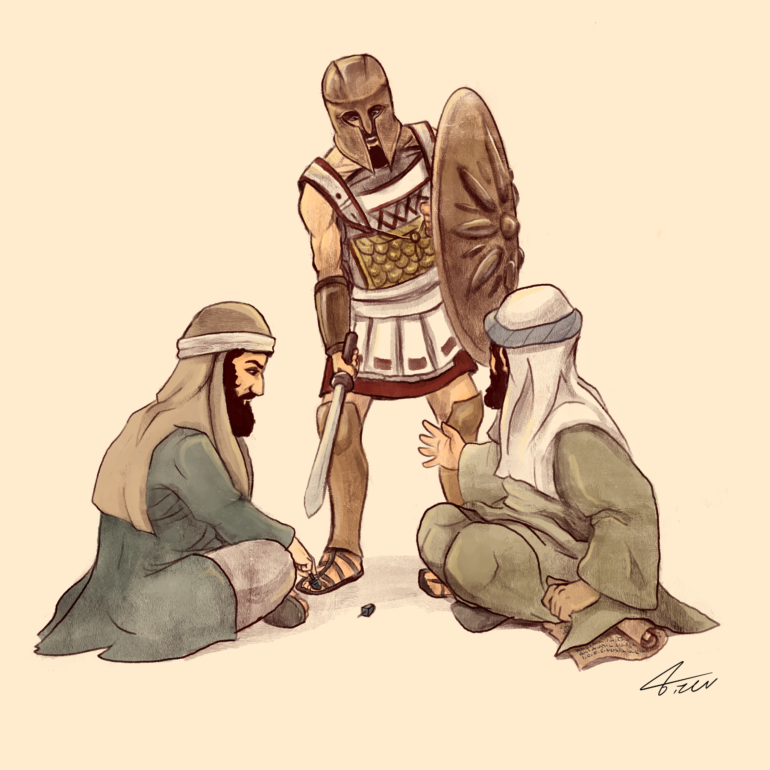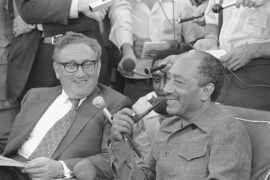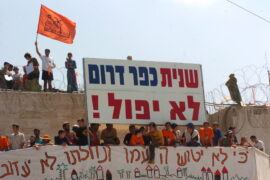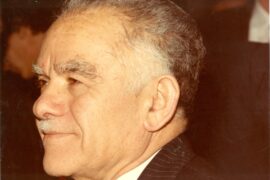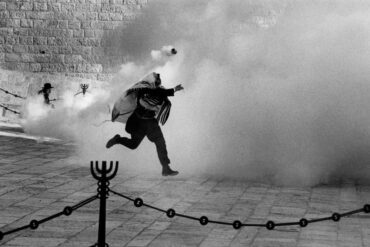The penultimate episode of a podcast series on the first Book of Maccabees.
For more content from VISION Magazine, subscribe to our newsletter and follow us on Twitter @VISION_Mag_, Facebook and YouTube. If you haven’t already, don’t forget to subscribe to our podcast on SoundCloud, iTunes, Stitcher, TuneIn, or Spotify and leave a rating and review to help us get our message out to a wider audience!
To support the podcast, head over to our PayPal portal and be sure to write a note that your contribution is for the podcast.
Hosted by: Robert Goodman
Transcript:
Shalom Aleikhem! And welcome back to – well, actually we’ve finished Sefer Maccabim, but welcome back nonetheless.
This is the penultimate episode in the series, and we’re going to use it to learn a bit about what happened after the Maccabean Revolt, besides what we’ve already learned about.
In the wake of the Maccabean Revolt, materially things get very good for the Jews, but spiritually things go downhill very fast. There are two major mistakes made that contribute to our people’s downhill trajectory, and we have to examine each of them in turn.
The first mistake: We mentioned in the shiur on chapter 13 how once full independence was achieved, Shimon took up the post of Kohen Gadol and also adopted the title of Nasi, but he notably does not call himself a melekh.
The reason for this dates all the way back to Parshat Vayeḥi:
When our patriarch Yaakov blesses his sons just before his death, he clarifies for each of them the role their individual tribe will play in building the goy kadosh, the holy nation destined to descend from them.
Within the collective nation, every tribe has a unique role to play that can’t be fulfilled by any of the other tribes – and each tribe has to remain true to their own mission if the nation as a whole can thrive.
For example, Yissakhar engages in full time learning to provide scholars for the Sanhedrin, while Gad trains warriors and commanders to head the army. When Yaakov blesses Yehuda, he tells him that “לא יסור שבט מיהודה” – “the scepter shall not depart from Yehuda.” That is, that the melekh will always be from the tribe of Yehuda (we know, of course, that once David ben Yishai, the tenth generation from Yehuda ben Yaakov, is anointed as melekh, the rightful kingship remains for his family forever).
The tribe of Levi, on the other hand, has a different role: they are tasked with the nation’s spiritual leadership. Levi lived interspersed among the other tribes in 48 cities across Eretz Yisrael. They taught the other tribes Torah and elevated them spiritually while the other tribes provided for their physical needs by giving them a tenth of their crops (and a sub-tribe within Levi, the Kohanim, served in the Beit HaMikdash with the aim of creating an environment of kedusha dedicated to inspiring the visiting Jews to a life of spiritual growth, instead of the Jews being drawn after the lure of idol worship).
Now Shimon ben Matityahu is a Kohen and, as such, he knows that although for all intents and purposes he is ruling the people, he cannot take on the title of melekh, as he does not descend from the tribe of Yehuda. His descendants also do not hail from Yehuda. But they unfortunately do not respect his distinction and Shimon’s descendants begin a new ruling dynasty in Eretz Yisrael known as the Malkhut Ḥashmonai, the Hasmonean dynasty which lasts 103 years until Herod the Great begins to rule. This was a grave error on the Hasmonean family’s part, and because of it their family was eventually wiped out completely.
There’s a well-known Ramban on the verse we quoted above – “לא יסור שבט מיהודה” – in which Ramban explains that although the Ḥashmonayim were supremely pious people and if not for them the Torah would have been forgotten from Bnei Yisrael, they suffered terribly because they adopted the mantle of kingship without being descended from Yehuda ben Yaakov and David ben Yishai.
This is the reason, explains the Ramban, why the sons of Matityahu fell by the sword in battle – because they ruled where they should not have (The Ramban explains how this is only true for the earlier Ḥashmonayim – the later ones were punished on account of being associated with the heretical Sadducees as we shall see).
The second mistake made by the Ḥashmonayim was that even though the country was liberated, there was a lot of Hellenistic influence still prevalent in Judea. Don’t forget, the Greeks had a completely different worldview to us, and even though we lived side-by-side with them in peace for a long time before the revolt, many of their foreign ideas penetrated our thinking.
This process was accelerated when Antiochus IV Epiphanes implemented the decrees of forced Hellenization. As a result, after the Maccabean Revolt the Hellenistic model of thinking still dominated Judea.
Now it must be emphasized that efforts were made to reintroduce Torah to the masses, because Antiochus outlawed that as well. But after such close proximity to Greek thought for such an extended time, many Jews were caught up in the Greek worldview without even realizing they were not seeing the world through the unique Hebrew worldview. You can learn Torah and still be thinking like a Greek.
And apparently the Ḥashmonayim didn’t make enough effort to undo this. They never went through the process of figuring out, just how were we influenced by so much interaction with Greek thought? How did we change because of our exile in Babylon? Have we changed our worldview because of it? What changes do we need to make to return to the worldview of our ancestors? Is there anything from the Greeks we might want to keep? And what do we have to discard?
But we never went through this process of decolonizing our identity and our worldview, and as a result, the Hellenistic influence was allowed to remain strong. As a result, many of the later Ḥashmonai kings became totally Hellenized themselves. And this paved the road for the Roman general Pompey to conquer Judea and subjugate us to Roman rule, as we shall see.
This is a lesson we, in our generation, have to take away from the Maccabean revolt: Once more we have liberated our country, but that’s only half the job. We have to go through this process of decolonization and examine how we were affected by our lengthy exile and what changes it made to our worldview, and learn to see with our ancient worldview once again, figuring out if there’s anything we picked up in exile worth keeping and what we want to discard. Again, using the metaphor of how we took gold out of Egypt; we need to figure out what we can give to the Mishkan, and what has to be discarded for fear of being used to make a golden calf.
So bearing both those problems in mind, the assumption of malkhut by kohanim and the lack of decolonization efforts, let’s take a look at what actually happened in Judea following the revolt. King Antiochus VII besieges Yoḥanan Hyrcanus in Yerushalayim, but relents at the onset of Sukkot and actually becomes Yoḥanan’s ally going forward. Yoḥanan then embarks on a campaign to conquer as much land as possible, and he greatly expands the borders of the Ḥashmonai kingdom. In doing so Yoḥanan brought many new peoples under Jewish control, and he does something never done before or since: He forcibly converts them.
This was a great mistake on his part; we Jews don’t go converting people by force. Anyone who’s read Megillat Rut knows that we discourage non-Jews joining us; we don’t encourage them, and we certainly don’t force them.
One of the forcibly converted people were the Idumeans, which proved to be a grave mistake, because one of the descendants of the Idumeans was king Herod, who murdered the remaining Ḥashmonayim when he assumed power.
As well as this forced conversion, Yoḥanan Hyrcanus renews the Jews’ friendship with the Romans and following an argument with the rabbis, defects from the Pharisees over to the Sadducees. As we mentioned in the introduction, the Sadducees were a breakaway sect who rejected the authority of the Oral Torah. They labelled the rabbis and G-d fearing Jews the “Peirushim” (Pharisees) – “separatists” – much like how the modern Reform movement labels Torah observant Jews as “Orthodox” – meaning “traditional, out of fashion.”
Of course, the whole idea of different sects or denominations within the Jewish world is a mistaken one – a Jew is a Jew is a Jew, and the very premise of dividing Judaism into different denominations, or even the notion of having Judaism as a religion, comes from the diluting our people’s Semitic identity into something that conforms with Western norms. It’s not who we really are.
The rest of Yoḥanan’s rule is relatively stable according to Josephus, but when his son, Yehuda Aristobulus, takes over from him, things get even worse. Yehuda Aristobulus was very Hellenized and also the first Ḥashmonai ruler to take the title of melekh, which earns him criticism from the Sanhedrin, so Aristobulus persecutes many of the rabbis and the Pharisees. He also has his own brother killed, but repents of this and dies after having reigned for a year.
Following his death the throne is taken by his Hellenized brother, Alexander Yannai. He expands the borders of Judea even further, but he becomes even further alienated from the rabbinic leadership and executes 800 Pharisees after forcing them to watch the slaughter of their families. During the executions, Alexander makes a Greek-style feast.
See how the seeds of Hellenism that were not uprooted immediately following the revolt are bearing their tragic fruit now. The family who did so much to free Judea from the grip of Hellenism, is now succumbing to the very thing it strived to break free from.
After Alexander Yanni’s death the rabbis make a great feast in celebration of this, but Yanni’s old supporters see what they’re doing and begin killing hundreds more of them. At this point Alexander’s widow, Shlomtzion, steps in as queen and actually manages to stop the killing and restore peace, at which point the rabbis make another feast – I know, Jews and food, but you’ve got to admit, they did have what to celebrate. Anyway, Shlomitzion rules for nine years, and she is a genuinely righteous woman. During her reign there is peace between the monarchy and the rabbis. In fact, the brother of Shlomtzion was none other than Rabbi Shimon ben Shataḥ, one of the leading scholars of his generation who is mentioned in Pirkei Avot.
The last two Ḥashmonai rulers were the sons of Shlomtzion, Hyrcanus and Aristobulus, both of whom are totally Hellenized. They fight over who should be the next king, and when they can’t decide, they decide to invite the Romans in to mediate their dispute. Josephus tells us what happens next in great detail: The Roman general Pompey jumps on the invite and moves his armies into Israel, slaughtering many Jews in the process and makes Hyrcanus the ruler of Judea.
This Roman intervention basically ends the era of Jewish independence which had begun under Matityahu and Yehuda and reached a peak under Shimon. The Romans had actually reneged on their alliance with the Jews and began to subjugate us many years earlier, during the time of Yoḥanan Hyrcanus, but they didn’t completely take over the country until Pompey came along. There’s an interesting G’mara in Tractate Avoda Zara that teaches how the Romans let us be for twenty-six years before beginning to subjugate us. I have a theory that perhaps this corresponds to the twenty six years we spent fighting the Greeks for independence, and as a reward HaShem granted us twenty six years of complete independence (again, that’s just a theory).
The Rambam teaches something very interesting about this in Mishna Torah: How the Ḥashmonayim’s alliance with Rome, which eventually caused our own downfall, actually has its roots in a much earlier event in Jewish history: When Yaakov was returning to Eretz Yisrael with his family and he met Esav, Yaakov bowed down to him. We know that “ma’ase avot siman l’banim” – “the deeds of the fathers are a sign for the children” – and the Rambam says that this bowing down was the root of the Ḥashmonayim eventually becoming dependent on Rome.
Following Pompey’s takeover of Judea Hyrcanus continues to rule, but he’s merely a puppet – he’s being guided by his general Antipater, who was a descendant of Idumeans forcibly converted by Yoḥanan Hyrcanus. Antipater managed to position himself in power and his son becomes a very famous builder. No, not Bob the builder – I’m talking about Herod the Great.
Herod taking the throne marks the official end of the Ḥashmonai dynasty, although he did marry a Ḥashmonai princess named Miriam. Unfortunately he was a very unstable man and he ended up murdering her and all remaining people who descended from the Ḥashmonayim. Hence we see how the Ḥashmonayim taking the throne really did result in their complete annihilation. It’s also why the G’mara in Bava Batra says that “anyone who says he descends from the Ḥashmonayim must be a slave” – because Herod, a descendant of the servants of the Ḥashmonayim, murdered the last of the true Ḥashmonayim, so anyone saying he descends from them must be descended from Herod, their slave.
During his 33 years as king, Herod undertakes some mammoth construction projects including the fortress of Masada and a makeover of the Beit HaMikdash, but he’s also an avowed Hellenist and aggressively pushes the Hellenization of the Jews which includes the persecution and murder of all rabbis. The Jewish upper classes also subscribe to Hellenism, while the mainstream Jews and the Zealot minority reject it, which contributes to the rise of the atmosphere of baseless hatred as different Jewish sects arise and the discord between them increases.
It takes a while, but eventually the combination of the internal strife among the Jews, the increasing Roman persecution and the unbridgeable ideological differences between the Jews and the pagan Romans culminate in the eruption of the Great Revolt, in which we declared war on Rome with initial success, but we tore ourselves apart with our baseless hatred and HaShem caused the war to end in disaster for us with the destruction of Bayit Sheini and more than a million Jews killed or sold into slavery.
This was the beginning of Galut Edom, from which we have still not fully recovered after almost two thousand years.
So how do we view the Maccabean Revolt in the larger context of Jewish history? In of itself, it’s a truly miraculous and inspiring story testifying to our people’s spirit, faith and determination. But because the physical liberation wasn’t followed up by ideological liberation, as we’ve discussed, everything the Maccabees accomplished was eventually undone and they fell victim to the very Hellenism they fought against.
But that wasn’t the end of it. Back in chapter 2 we briefly mentioned the Zealots, the faction in Judean society who spearheaded the fight against Roman rule. Following the destruction the Rabbinic leadership, desperate to bring relief to a decimated people, tried to make peace with the Roman authorities and sought to downplay the Zealots as a bunch of “extremists” and demonstrate that they, the Zealots, were not an accurate representation of our people.
The rabbis made efforts to distance the rest of the Jews from the teachings of the Zealots, for fear it would incite them into further rebellion against the Romans and bring down their wrath upon an already wrecked and shattered people. Mind you, even with their efforts the Jews still revolted several times more, culminating in the Bar Kokhba Revolt nearly seventy years afterwards which was finally crushed when the Roman army, led by General Julius Severus, destroyed Betar, the last stronghold of the Jewish forces.
All this meant that the teachings of the Zealots, the Torah that demands the liberation of Eretz Yisrael, that motivated both them and the Maccabim to fight, was largely lost to the general Judean populace.
But as anyone familiar with Rav Yehuda’s podcast may well have heard, this Torah never went away. Rather, it became the property of giants, being passed down teacher to student by the greatest leaders of the generations, like Rabbi Yehuda HaLevi in Crusader times, the Maharal of Prague in the 16th century CE, and the Vilna Gaon, around 200 years after him. But it was not studied by the average Jew on the street – until the year 1967, when the recapture of Yerushalayim in the Six Day War led to this revolutionary Torah erupting back into the world like a volcano, and it’s now being learned by many Jews in Israel.
This brings up to the end of this episode. We’ll return next time for one final episode in which we run through the Maccabean revolt one more time and consult the Rambam to remind us what the Maccabim were fighting for.

